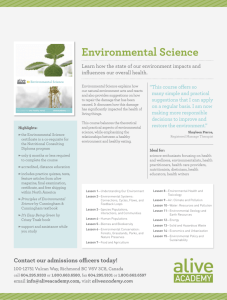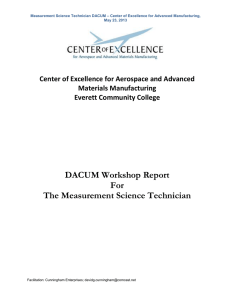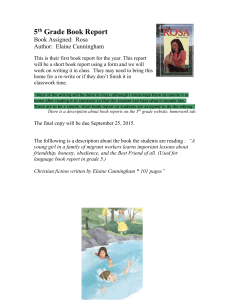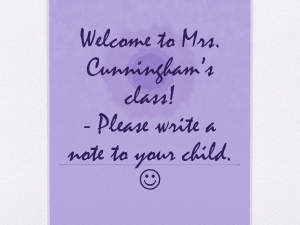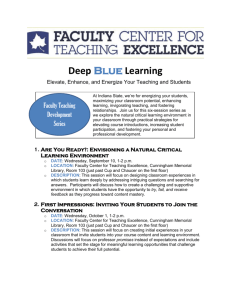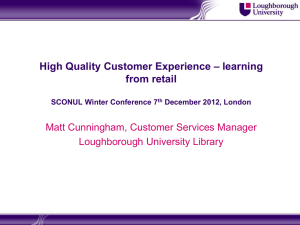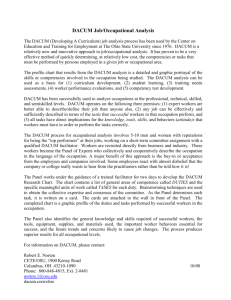Construction Center of Excellence; DACUM Workshop Report Leadership Responsibilities
advertisement
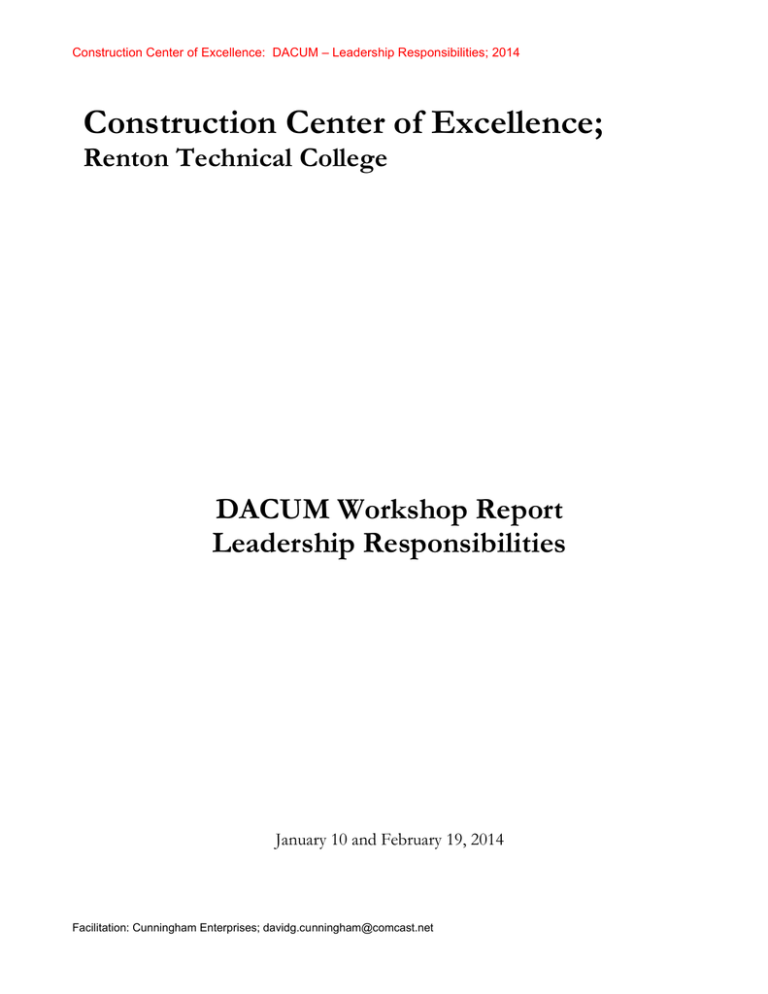
Construction Center of Excellence: DACUM – Leadership Responsibilities; 2014 Construction Center of Excellence; Renton Technical College DACUM Workshop Report Leadership Responsibilities January 10 and February 19, 2014 Facilitation: Cunningham Enterprises; davidg.cunningham@comcast.net Construction Center of Excellence: DACUM – Leadership Responsibilities; 2014 Agenda: Focus Question: “What are the leadership responsibilities for a journeyman supervisor or lead contractor on a typical northwest construction project?” Noon Welcome from Shana Peschek Overview of previous AWB/CCE Industry Forum research work and this DACUM workshop 12:30PM Introduction of the panel members – panel members Introduction to the DACUM process and the agenda - Dave Cunningham Workshop I Mapping out the initial profile of the Data Management Professional Break Finalizing the work profile 2:30PM Refinement of the Work profile and the component tasks Identification of priorities 3:00PM Adjourn Participants: 1. 2. 3. 4. 5. 6. 7. 8. 9. 10. 11. 12. 13. 14. 15. 16. 17. 18. 19. 20. 21. 22. 23. 24. 25. 26. 27. Elmer Arter, WW Coordinators Association Tani Baile, LNI Stephen Bridgeford, Pierce College Christine Campbell, Clover Park T.C. Adiana Gamboa, Construction Industry Training Council Kristi Grassman, WFC Peter Guzman, City of Tacoma Lauren Hadley, SSCC Georgetown Apprenticeship & Education Center Amy Johnson, Association of Washington Business Albertus Kariko, Veraillia/Saint-Gobain Containers Betty Klattenhoff, OSPI Mike Kuntz, NWLETT Apprenticeship Coordinator Peter Lahmann, Laborers Apprenticeship Coordinator Jae Lee, Renton Technical College Ronald Lytle II, Veraillia/Saint-Gobain Containers Mark Martinez, Pierce County Building Trades Amy Moorash, JBLM Lauren O‟Brien, Port of Seattle Dave Perrin, Construction Industry Training Council Shana Peschek, Construction Center of Excellence Kairie Pierce, WSLC Halen Sigmund, Construction Industry Training Council Mellody Stell, NWR EEO Officer/OJT SS/TERO Coordinator Curtis Takahashi, Snohomish County WDC Dennis Wallace, OSPI Keith Weir, Seattle Building and Construction Trades Dave Cunningham, - DACUM Facilitator, Cunningham Enterprises Facilitation: Cunningham Enterprises; davidg.cunningham@comcast.net Construction Center of Excellence: DACUM – Leadership Responsibilities; 2014 Introductions: Shana Peschek, Director of the Construction Center of Excellence at Renton Technical College, welcomed everyone and provided copies of the results of a 2012 industry forum completed in collaboration with the Association of Washington Business. This document outlines labor market data and industry survey results that project job growth in the area of construction supervisors in the next 5 to 7 years. It was made clear that this document would serve as resource material for today‟s work and in the future. Dave Cunningham introduced the group to the DACUM process and explained that today‟s work would be part one of a two part process. The product today would be a detailed profile of the leadership responsibilities expected of a lead journeyman, foreman or lead contractor on a typical construction project in the Pacific Northwest. Part two, which will occur later in February, will be to identify the knowledge, skills and aptitudes required to do this work. The outcome of both events will be used as the foundational working documents for ongoing curriculum development for a certificate in Leadership Development. It is the intention of the Center of Excellence support the development of this certificate and to make it available to the CTC system to offer to experienced journeymen and others who wish to move into leadership positions. It was pointed out in the course of the discussions that several of the trades and industry associations have certain elements of leadership training curriculum already built into their certified apprenticeship training and going forward, the Center of Excellence will work with the coordinators of the trades on this. While several made the point that in the past foremen often developed their leadership skills and knowledge on the job, this certificate will accelerate this educational process and be a stackable certificate that can be used toward the various construction management degree programs in the CTC system. It is further hoped that this new certificate in Leadership will support improved safety compliance, sustainability and encourage people in the trades to further their careers. Viable career paths for the construction industry are especially useful to those who have given years to physical labor and need to transition to positions that are less difficult on their bodies. Dave Cunningham then began the DACUM process. The following chart represents the detailed profile of the leadership responsibilities of a journeyman lead, foreman or contract lead according to the participants who volunteered their time for this work. Final Wrap Up: February 20, 2014 In discussing the final product of this work the panel were quite clear that the biggest challenge facing the colleges in developing the new curriculum for leadership development – will be teaching the „soft skills.‟ Moreover it was emphasized that most lay-offs in this industry can be traced back to a big deficit in soft skills. So the message seemed to be clear as to where the emphasis of time and energy needs to be in this new undertaking. Facilitation: Cunningham Enterprises; davidg.cunningham@comcast.net Construction Center of Excellence: DACUM – Leadership Responsibilities; 2014 The Profile of the Leadership Responsibilities (edited February 19) Major Leadership Functions Risk Management A Human Resource Management B Contract Management & Compliance C Safety Management D Job Site Cost Control E Scheduling F External Relations G Typical Leadership Tasks Tan - Very common and also most challenging: Purple – most challenging: Green – most common tasks Visualize next steps & anticipate outcomes Keep abreast of industry technology & trends A1 Use all communication modes well (electronic & F2F) A2 A3 Solve problems consistently (technical, personnel, fiscal, scheduling etc.) A5 Communicate effectively with all levels of employees A4 Practice standard industry professional ethics A6 Oversee worker performance B5 Ensure daily logs and payroll B7 Foster a welcoming & inclusive working environment B2 Manage personnel – especially hiring B4 Schedule personnel Respond appropriately to all communications B8 Update and maintain project documentation Ensure all qualitymetrics & codes are met Participate in the Bid Process & conduct after-action reviews C1 C2 Conduct safety inspections & lead wkly meetings D2 Resolve disputes around change orders G1 Reduce waste & manage resources efficiently E2 Monitor timeline for optimal performance F2 Communicate with customers & other relevant partners G2 Facilitation: Cunningham Enterprises; davidg.cunningham@comcast.net Communicate liabilities to colleagues Mitigate & manage risk A8 A9 A11 A12 A7 Follow all S.O.P.s when accidents occur B3 Educate others and enforce job-site safety D1 Control project cost (labor, materials, equipment) E1 Schedule with standard industry software F1 Resolve conflicts (job related) Identify liabilities associated with projects Resolve internal personnel conflicts B1 B6 Keeping abreast of the broad intent of the task Oversee training of apprentices & employees B9 Manage (work/task schedule, delegation, motivation etc) B10 Negotiate a lot (change orders and some) A10 Manage project team members and hold accountable for company drug policy Ensure compliance with on-site, Title VI, all Labor contracts Affirmative Action & EEO Regulations B11 B12 C3 Maintain & educate partners on scope of the work C4 Follow blue-prints & all specifications C5 Comply with all applicable government regulations C6 Establish accountability for safety efforts D3 Comply with all related OSHA/WISHA regs D4 Keep all staff certifications up to date D5 Ensure that all safety regulations & codes are complied with 100% D6 Manage all logistics of material requisition E3 Document daily activities F3 Analyze & interpret project budgets E4 Track and document project schedule F4 Manage all partner relationships G3 Plan and prepare schedule meetings G4 Use standard industry software to manage all project-related costs E5 Document phases of the T.S and address all project scheduling delays F5 F6 Collaborate with contractors on design and suppliers with delivery schedules G5 Manage change A13 Arrange employee training on Risk Mgt, Safety, Cost control, Scheduling, Contract Mgt, & External Relations B13 C7 Implement the sustainability & Environmental plan on the job site C8 Conduct an accident investigation D7 Act on all safety violations immediately D8 Comply with all trade agreements Construction Center of Excellence: DACUM – Leadership Responsibilities; 2014 DACUM Report continued: February 19, 2014 February 19, a second meeting occurred to develop the knowledge, skills and aptitudes (KSAs) required of lead journeymen when they assume the leadership responsibilities as described in the previous chart. The Focus question for this workshop was: “What are the KSAs required to carry out the leadership responsibilities on a typical NW construction project?” Participants: 1. 2. 3. 4. 5. 6. 7. 8. 9. 10. 11. 12. 13. 14. Stephen Bridgeford, Pierce College Lauren Hadley, Georgetown Apprenticeship & Education Center Amy Johnson, Association of Washington Business Lauren O‟Brien, Port of Seattle Shana Peschek, Construction Center of Excellence Kairie Pierce, Washington State Labor Council Mellody Stell, NWR EEO Officer/OJT SS/TERO Coordinator Curtis Takahashi, Workforce Snohomish Joan Weiss, Worker Center-Martin Luther King Jr. County Labor Council Erich Smith, Build it Smart Paul Garcia, Workforce Snohomish Lee West, Instructor, Bricklayers and Allied Craftworkers Local 2 Randy Johnson; Apprenticeship Coordinator, Bricklayers and Allied Craftworkers Local 2 Dave Cunningham, - DACUM Facilitator, Cunningham Enterprises The Results are as follows: The Preferred Attributes: Decisive High integrity Recognizes and honors boundaries Has „grit,‟ Trustworthy & dependable Big picture and visionary Fairly likeable personality Is detail oriented Good listener Shows leadership traits Professional style Accepts accountability Ethical Respects confidentiality Technically minded Is patient Notes: Blue text denotes most desirable attributes Facilitation: Cunningham Enterprises; davidg.cunningham@comcast.net Construction Center of Excellence: DACUM – Leadership Responsibilities; 2014 The Foundational Knowledge Base Risk Management A The basic principles of Risk Management in the construction industry A1 Estimating and budgets A2 The Legal Business Environment B Comprehensive knowledge of applicable Labor law (Purple shading denotes most important elements) The Accident Prevention The Construction Industry Contracting Program Processes Processes C D E OSHA/WISHA regs C1 Employer Safety S.O.P.s B1 C2 Local & contract Labor options & requirements B2 Industry safety certifications i.e., First Aid/CPR etc C3 MSDS C4 Site specific safety requirements C5 Standard professional ethics B3 Accident procedures & investigations D1 Standard H.R. Practices F Principles of Sustainability G Knowledge of applicable, sustainable & environmental policies, practices & regulations The phases of a typical project E1 Basic Labor relations F1 Meeting preparations & scheduling times D3 Supply networks & lead times D2 Advanced knowledge of the construction process D4 Contract bid regulations & processes E2 The order delivery process The „after-action‟ review processes D5 D4 All aspects of a typical construction project D6 The specific construction phase & site plan E3 The customer base and the external partners F2 The principles of human motivation in the workplace F3 The standard metrics for quality measurement D5 Engineering Controls Lean Principles & their application in Construction Projects C6 D7 Facilitation: Cunningham Enterprises; davidg.cunningham@comcast.net Constraints of different materials E4 Standard policy & procedures E5 Know the link between contracts & materials E6 G1 The waste stream and recycling options Recruiting & selecting good employees F4 G2 Construction Center of Excellence: DACUM – Leadership Responsibilities; 2014 The Core Skills or Competencies (Purple shading denotes the most critical skills) Construction Industry IT A The ability to use and adapt a wide range of Ecommunication tools The Construction Industry Soft Skills B Ability to organize work, space equipment & materials consistently B1 Time management A1 Effectively use industry software to update & maintain project documentation A2 B2 Able to work within constraints & meet deadlines B3 Ability to work well with others B4 Communications Technical C D Effective interpersonal communications (verbal, email etc) C1 Resolve safety issues quickly and completely C3 Excellent written and verbal skills C4 Solve typical on-site problems B5 The ability to document the chronology of activities & the needs of personnel C6 Ability to track and monitor the details Ability to implement new policies and procedures B5 C9 Clearly communicate to others: The scope of a project, the afteraction reviews, the regulations, the sustainability plan C2 Ability to read and interpret contract documents D1 Read and interpret blue prints & project specs D2 Operate a range of equipment including fork-lifts, aerial lifts, mixers etc Ability to determine if the phases of a project are on track for completion as planned D3 D4 Ability to implement Engineering controls Ability to read and comprehend applicable laws and regulations D5 D6 Ability to apply math functions in developing and completing a project D7 Ability to interpret methods and materials Bi-lingual C5 Ability to facilitate a meeting C7 Ability to prepare an agenda and conduct a successful meeting C8 Ability to manage people, resolve conflicts and build effective working relationships C9 Facilitation: Cunningham Enterprises; davidg.cunningham@comcast.net Budget Management E D8 Create typical project budget E1 Monitor a typical project budget E2 Identify signs that a budget may be off track E3 Utilize effectively standard estimating and budgeting processes E4
